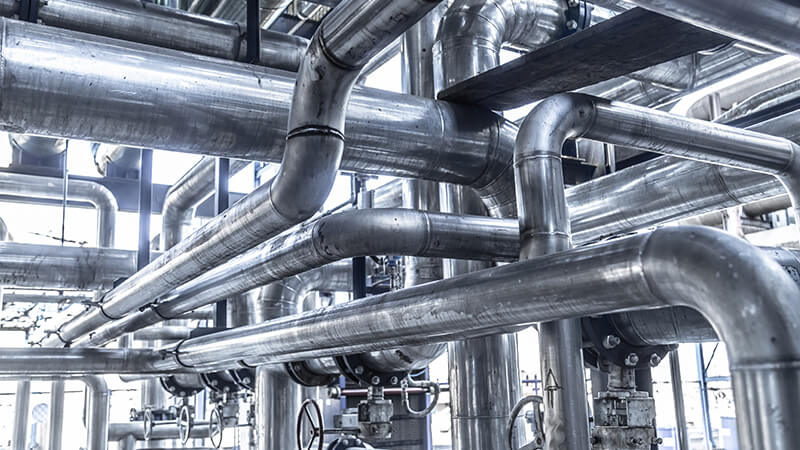Orbital welding is so extended because many foods, beverages, and pharmaceutical companies require their pipes should be welded with an orbital system. The main reason orbital welding is used on these plants is that they manufacture products for consumption and that require quality levels of weld in their piping systems.
Other common uses of orbital welders are related to the petrochemical industry. But first, let’s explain what orbital welding is.
What is Orbital Welding
Orbital welding is a specialized area in the welding field where the arc is rotated automatically around a static piece, in a continuous process. This process is ideal when repeatable and high-quality welding is required. The piece is most likely some sort of stainless steel pipe.
For many industries, stainless steel is the best material due to life cycle cost, strength, sanitation, and being more economical in the long term. But in some cases, like when they are building oil and gas pipelines, it can be just carbon steel or other appropriate metal.
By using orbital welding as a mechanized process, these industries can rely on an easy to make and remake as well as dependable welding for their pipes.
When Orbital Welding is required
As stated before, some industries require this kind of welding more than others. The chemical, oil and gas, pulp & paper, construction, food & beverage, and pharmaceutical industries are the ones who use orbital welding the most.
For example, in the United States, the biopharmaceutical industry has experienced a huge increase in this welding process, due to the need for holding documentation of welding for inspection. These records are required to obtain validation from the U.S. Food and Drug Administration (FDA).
All these requirements are valid because food, beverage and pharmaceutical industries use to have long lines of production where liquids and biological material go through.
As well, strict controls should be taken into consideration in order to replace pipes in an orderly fashion. This may imply the use of different sizes of weld heads for different size pipes.
Fortunately, many of the current equipment for orbital welding can store, receive or send data for a particular welding job, allowing this process to be repeatable and run smoothly.
Another use of the orbital welding
But when orbital welding is required for the building of oil and gas pipelines, big size equipment is required.
In those cases, a track is used to set the weld head. Then the welding is done while it goes around the piece. This way less mistakes are committed by operators.
How is Orbital Welding carried out
Despite the particular type, orbital welding is carried out when the electrode is rotated in an orbit around a joint on a rotor. This rotor can be held by a couple of trails or an adaptable piece (clamp) that is fixed to the joint to be weld.
The rotor and electrode, inside the weld head, rotates around the tube, producing the weld puddle. This mix is surrounded by a shielding gas that protects the molten weld puddle.
But before the welding can get started, is needed to center the joints in the fixture, in order for the electrode to be lined up with the weld joint precisely. Setting the right position for the weld joint is highly important. If the settings are not the right ones, the weld can be deeply affected.
To achieve such a line up in the weld joint, external clamps are used. For small diameter pipes -like sanitary ones- external clamps hold pieces together.
But when we are talking about a big size pipe -like the ones used in the oil and gas industry- internal and adaptable clamps are used commonly.
Another issue to set up
Another issue that can affect the orbital welding job is the purging technique used. Usually, the purge gas is argon, which is appropriate for these jobs.
After setting this, it is needed to define the correct flow and pressure across the weld joint and through the tubing.
This shielding gas, fed by the weld head has the purpose of protects the welding puddle from any contamination. Once you have taken care of all this matter, is time to perform the job.
Repeatability in the orbital welding jobs
Like any other automated process in the workshop, orbital welding should be repeatable. For this to happen, a program should be created. Every one of these programs should contain the step-by-step procedure according to the base material, wall thickness and tube diameter.
In most cases, orbital welding equipment has the capacity to record operations. This is especially important in sanitary workshops because reports about welding jobs should be presented to the authorities.
Having all the information from the welding recorded allows to track and analyze data to help eliminate errors. Actually, after done, the process can be audited in order to improve any failure.
Other benefits from the ability to record and remake easily orbital welding jobs can improve accuracy and increase productivity, by reducing the chances of human error.
Equipment required for Orbital Welding
There are several types of equipment, used for different applications. The main differences are the materials to be welded and their sizes.
We distribute Steelmax products because they are reliable and give solutions to a variety of needs.
Also, other needs can be covered wit Orbitalum products. As they can be more specific, we invite you to contact us in order to define which one is the most suitable for your company.
You are not alone in this
We, the people at IFExport have been working with industrial processes, like orbital welding, since 1979. So, we can tell you one thing or two about it.
Helping our clients to implement this type of welding effectively is one of our goals. We can’t wait to apply our expertise to your workshop also.





